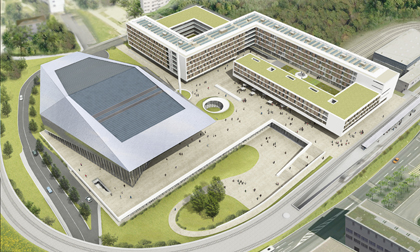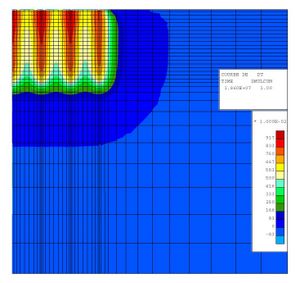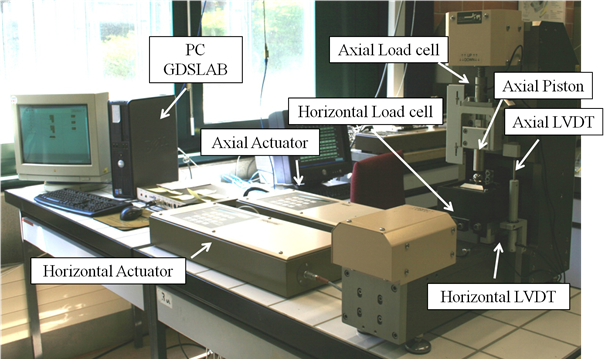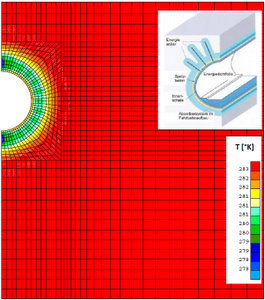Geotechnical Reliability of thermo-piles energy storage in soils
Involved persons: Prof. Dr. Lyesse Laloui, Dr. Fabrice Dupray, Thomas Mimouni
A new 3.5 years project entitled: “GRETEL – Part II: Geotechnical REliability of Thermo-piles Energy storage in soils” is now starting. It is granted by EOS Holding

Image: Swiss Tech Convention Center, courtesy of Richter & Dahl Rocha Architects |
This project involves in situ testing of four energy piles on the site of the New Swiss Tech Convention Center. All information about this unique tool are gathered on a dedicated page, here. |

Heat exchanger geostructures consist in using ground thermal energy via fluid pipes cast in concrete foundation structures. This project deals with the transition from current heating and cooling technologies, which only make use of ground energy, to seasonal energy storage systems that can input summer thermal energy in the ground, to be extracted in winter. The development of solar building design has given way to a great variety of energy storage technologies, and the one we propose to explore is perfectly adapted to an existing technology, solar thermal collectors. Greater amounts of energy obtained with solar input and exchanged with the foundation soil of a building will lead to higher ground temperatures in summer, while it is also possible to cool the soil to lower temperatures in winter in order to maximise the global efficiency of thermo-piles energy storage, in the absence of significant water flow (fine-grained soils). The limits of this principle will be defined by the geotechnical aspects that are imposed by the dual function of thermo-piles. The structural integrity of the building must be maintained under high temperatures, low temperatures, and with wide amplitude seasonal cycles. The first phase of this project has been funded by EOS Holding through the present collaboration with the Energy Center. It has allowed us to estimate the acceptable range of temperatures in fine-grained soils, and explored the short-term behaviour of these soils under near-freezing temperatures. The second phase has the ambition to identify and perform all the studies required to ensure the long-term behaviour of the structure, in terms of thermo-hydro-mechanical cyclic behaviour, and for all the structural consequences of it. The whole project will allow the publication of design recommendations on both the energetic and structural sides.
Keywords: energy piles design, energy storage, short-term behaviour, long-term behaviour.
Constructive recommendations for optimized and reliable heat exchanger pile systems
Involved persons: Prof. Dr. Lyesse Laloui, Alice Di Donna
 The surface of the Earth contains a great potential of thermal energy that can be used for heating and cooling residential, office and commercial buildings at low additional cost, through the installation of energy geostructures. The originality of these structures is to combine fundaments, necessary for supporting the building, with the heat exchanger system, able to extract heat from the ground during winter and expel it during summer. Although these technologies are already installed in many places around the world, for years their dimensioning has been based on empirical considerations and the understanding of their thermo-mechanical behaviour is still limited. The aim of this project is to gain inside the behaviour of energy geostructures and their interaction with the surrounding soil, in order to end up with appropriate design procedure for engineers.
The surface of the Earth contains a great potential of thermal energy that can be used for heating and cooling residential, office and commercial buildings at low additional cost, through the installation of energy geostructures. The originality of these structures is to combine fundaments, necessary for supporting the building, with the heat exchanger system, able to extract heat from the ground during winter and expel it during summer. Although these technologies are already installed in many places around the world, for years their dimensioning has been based on empirical considerations and the understanding of their thermo-mechanical behaviour is still limited. The aim of this project is to gain inside the behaviour of energy geostructures and their interaction with the surrounding soil, in order to end up with appropriate design procedure for engineers.
We developed a new geotechnical design method, based on the load transfer method, and implemented it into a software called Thermopile able to determine the extra stresses and displacements that come from the temperature variations in a heat exchanger foundation pile.
Keywords: energy geostructures, heat exchangers, soil-structure interaction, ThermoPile.
Direct shear device for testing the soil-concrete interface at high temperature:
When piles are employed for energy purposes, they are subjected to temperature variations in the range of 1-60 °C. In order to study this aspect experimentally at the laboratory scale, a new advanced direct shear device was developed.

Three main modifications were introduced with respect to the commercial version of the machine: the geometry of shear box was re-designed to accommodate the concrete sample and the heater, the normal stiffness control was implemented and a heating system was introduced. This latter includes an innovative idea for heating represented by the use of an electrical resistance connected to an electrical generator. The calibration of the apparatus includes the thermal effects on all the components involved in the apparatus.
- Geometry: The lower part of the shear box was completely re-designed adapting it for the accommodation of the concrete sample and the heating system.
- Normal stiffness control: It was implemented because the most appropriate way to reproduce the soil-pile interface real conditions at the laboratory scale is the constant normal stiffness conditions.
- Temperature control: It is composed of:(i) an electrical resistance, (ii) an electrical generator, (iii) an isolation system and (iv) a thermocouple. The idea to use an electrical resistance for heating is innovative and minimizes the space required for the installation of the heating device.
Sponsored by Swiss Federal Office of Energy
Heat exchanger anchors for thermo active tunnels
Involved persons: Prof. Dr. Lyesse Laloui, Dr. Fabrice Dupray, Thomas Mimouni
 The use of tunnel anchors as heat exchanger represents a unique opportunity for a sustainable and cost effective heating/cooling of buildings or underground structures in the vicinity of tunnels.
The use of tunnel anchors as heat exchanger represents a unique opportunity for a sustainable and cost effective heating/cooling of buildings or underground structures in the vicinity of tunnels.
This project aims at validating the feasibility of heat exchanger anchor technique in tunnelling.
Two practical cases are studied: anchored retaining walls, a common practice for cut-and-cover tunnels, and tunnel anchors, as used in soils or soft rocks. Our action focuses on the determination of the optimal energy geo-structure design, considering the thermal properties of the ground, the expectable energy demand (for instance a public building), and the static behaviour of anchors.
Sponsored by Swiss Federal Roads Office and Swiss Tunnelling Society
Keywords: heat echanger anchors, tunnelling, energy design, geo-structural behaviour.
Publications
Journal articles
Energy and geotechnical behaviour of energy piles for different design solutions
Batini N., A. F. Rotta Loria, P. Conti, D. Testi, W. Grassi Laloui, L., Applied Thermal Engineering, 2015.
Numerical modelling of energy piles in saturated sand subjected to thermo-mechanical loads
Rotta Loria A.F., Gunawan A., Shi C., Laloui L., Ng C.W.W., Geomechanics for energy and the environment, 2015.
Response of soil subjected to thermal cyclic loading: experimental and constitutive study
Di Donna A., Laloui L., Engineering Geology, 2015.
Rotta Loria A.F., Di Donna A., Laloui L., Journal of Geotechnical and Geoenvironmental Engineering, 2015.
Laloui L., Olgun C. G., Sutman M., McCartney J. S. and Coccia C. J. et al., DFI Journal: The Journal of the Deep Foundations Institute, 2014.
Numerical analysis of the geotechnical behaviour of energy piles
Di Donna A. and Laloui L., International Journal for Numerical and Analytical Methods in Geomechanics, 2014.
Centrifuge modelling of heating effects on energy pile performance in saturated sand
Ng W. W. C., Shi C., Gunawan A.,Laloui L. and Hanlong L., Canadian Geotechnical Journal, 2014.
Centrifuge modelling of energy piles subjected to heating and cooling cycles in clay
Ng W. W. C., Shi C., Gunawan A.,Laloui L., Geotechnique letters, 2014.
Estimating the geothermal potential of heat exchanger anchors on a cut and cover tunnel
Mimouni T., Dupray F., Laloui L., Geothermics, 2014.
Numerical analysis of seasonal heat storage in an energy pile foundation
Dupray F., Laloui L., Kazangba A., Computers And Geotechnics, 2014.
Towards a secure basis for the design of geothermal piles
Mimouni T. and Laloui L., Acta Geotechnica, 2014.
Understanding the Thermo-Mechanical Behaviour of Energy Piles
Laloui L. and Di Donna A., Civil Engineering, 2011.
Advances in energy piles analyses
Laloui L. and Di Donna A., Publication of the Swiss Geotechnical Society, 2011
Geotechnical analysis of heat exchanger piles
Knellwolf C., Peron H., and Laloui L., Journal of Geotechnical and Geoenvironmental Engineering, 2011
ACMEG-TS : a constitutive model for unsaturated soils under non-isothermal conditions .
François B., and Laloui L., International Journal for Numerical and Analytical Methods in Geomechanics, 2008
Non-isothermal Plasticity Model for Cyclic Behaviour of soils.
Laloui L., and Cekerevac C., International Journal of Numerical and Analytical Methods in Geomechanics, 2008.
Experimental and numerical investigation of the behaviour of a heat exchanger pile.
Laloui L., Nuth M., and Vulliet L., International Journal for Numerical and Analytical Methods in Geomechanics, 30(8):763-781, 2006
Experimental study of thermal effects on the mechanical behaviour of a clay.
Cekerevac C., and Laloui L., International Journal of Numerical and Analytical Method in Geomechanics, 2004
Comportement d’un pieu bi-fonction, fondation et échangeur de chaleur.
Laloui L., Moreni M., and Vulliet L., Canadian Geotechnical Journal, 2003
Book chapters
Alternative uses of heat exchanger geostructures
DuprayF., Mimouni T. and Laloui L., in Energy Geostructures: Innovation in Underground Engineering, L. Laloui and A. Di Donna (eds.), ISTE Ltd. and John Wiley and Sons, Hoboken, 2013
Thermo-pile: a numerical tool for the design of energy piles
Mimouni T. and Laloui L., in Energy Geostructures: Innovation in Underground Engineering, L. Laloui and A. Di Donna (eds.), ISTE Ltd. and John Wiley and Sons, Hoboken, 2013
Full-scale in situ testing of energy piles
Soil response under thermomechanical conditions imposed by energy geostructures
Di Donna A. and Laloui L., in Energy Geostructures: Innovation in Underground Engineering, L. Laloui and A. Di Donna (eds.), ISTE Ltd. and John Wiley and Sons, Hoboken, 2013